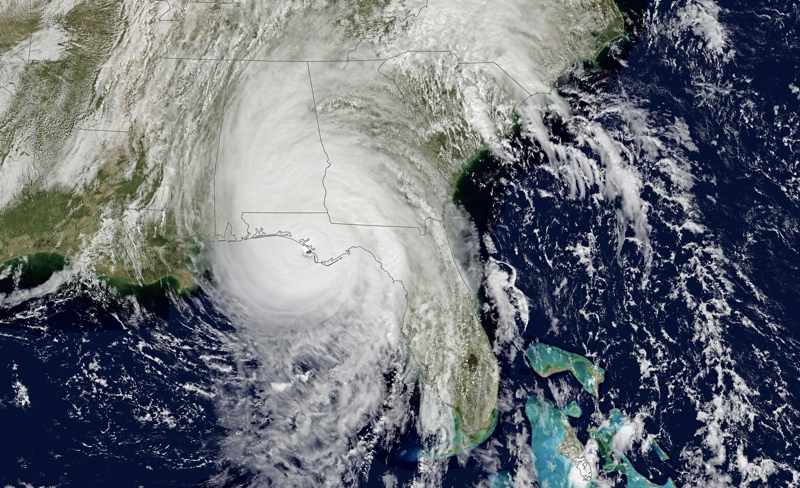Hurricane Michael’s wind speeds at landfall in Florida have been upgraded by the U.S. NOAA’s National Hurricane Center scientists in their final tropical cyclone report, now estimating them as having reached Category 5 at 160 mph.
 This means hurricane Michael, which slammed into the Florida Panhandle region in October 2018, has now become the fourth Category 5 hurricane to ever make landfall in the United States and the first Cat 5 storm since hurricane Andrew in 1992.
This means hurricane Michael, which slammed into the Florida Panhandle region in October 2018, has now become the fourth Category 5 hurricane to ever make landfall in the United States and the first Cat 5 storm since hurricane Andrew in 1992.
NOAA said that its post-storm analysis of hurricane Michael meant estimates of sustained winds at landfall were raised to 160 mph, a 5 mph increase over previous estimates from the association.
“The final best track intensity estimate of 140 knots (160 mph) was determined by a review of the available aircraft winds, surface winds, surface pressures, satellite intensity estimates and Doppler radar velocities – including data and analyses that were not available in real time,” NOAA further explained.
The final tropical cyclone report for hurricane Michael also pegs the minimum central pressure at landfall for the storm at 919 mb, meaning the hurricane becomes the third-lowest pressure on record for a landfalling U.S. hurricane since reliable records began in 1900, behind the Labor Day Hurricane of 1935 (892 mb) and Hurricane Camille of 1969 (900 mb).
Of course changes in intensity factors in hurricanes can have significant ramifications for the triggers of reinsurance and insurance-linked securities (ILS) contracts that may use them, as was seen in the case of a central pressure update in the final TC report for hurricane Patricia and the MultiCat Mexico catastrophe bond.
Changes in hurricane intensity-related factors can have ramifications for any contracts, reinsurance or insurance-linked securities (ILS), that might use those factors as a variable within their trigger design.
In the main, this would be related to parametric triggers, as was seen in the case of hurricane Patricia’s impact on Mexico and the increased central pressure measurement that meant the MultiCat Mexico catastrophe bond paid out a chunk of its principal.
In that case a storm chaser had recorded actual pressure measurements on the ground, which NOAA took and extrapolated alongside its own data resulting in an increase to the minimum central pressure which caused the parametric trigger to be breached and a 50% payout to come due.
With Patricia it was the “best track data” from NOAA’s final tropical cyclone report that was the official reporting data set used to determine whether the parametric trigger had been breached or not.
In that case it was minimum central pressure at the time the centre of the hurricane crossed into or was situated within the parametric cat-in-a-box zone that mattered.
Other parametric triggers over the years have used a range of factors from NOAA hurricane reports and recordings as inputs and variables, including wind speeds, locations of the eye of the storm, and even the category a storm reaches.
This increase in the intensity of hurricane Michael to category 5 is also seen in the final tropical cyclone report for this storm, so if any reinsurance or ILS contracts did exist that featured hurricane category from the final tropical cyclone report as a variable or input in the trigger, such as one that defined a payout as due if a category 5 hurricane makes landfall in the state of Florida, then they would have paid out on this increase to the intensity.
However, we think it’s unlikely that any contracts actually exist right now that would have paid out on this increase alone, as parametric triggers tend to include more than simply a variable of hurricane category as the trigger.
Even the addition of a location alongside the need for a category 5 landfall, such as the coastal region around Miami, would make for a far better and more accurate trigger than an “any Cat 5 landfall in Florida” trigger variable.
The reason for this is that parametric trigger structures tend to look to minimise basis risk by adding a range of variables to ensure payouts are fast and as accurate as possible, paying out only when they are deemed as supposed to.
The fact parametric triggers are designed to be quick to payout is also a key consideration with respect to Michael, as we’re now six months after the storm and so using the final tropical cyclone report erodes that benefit of quick paying coverage. Hence we’d imagine trigger structures are more likely to utilise the live hurricane report data, than a rehashed report six months after the storm.
Parametric reinsurance and ILS contracts that purely utilise category + location of a hurricane as trigger inputs are likely few and far between now, and almost certainly not focused on the area of the Panhandle and eastern Gulf coast where Michael came ashore.
We’ve also heard of industry-loss warranty (ILW) hybrids that take an industry loss estimate for a hurricane + another input such as wind speed or location, but use of category here is likely very rare and we feel there are unlikely to be any currently live that could have been affected, as the industry loss figure for Michael has not risen as high as likely required.
In fact, hurricane Michael is now estimated to have caused an industry loss to insurance and reinsurance interests of $11 billion by broker Aon, hence it’s not the kind of major loss that would trigger an instrument that had a Cat 5 variable in the trigger, we feel.
Wind speed alone could also be a factor in some parametric insurance and reinsurance contracts, as well as in combination with an ILW in a hybrid loss transfer structure.
But a 160 mph wind speed trigger would again more likely have location as another variable or input to the trigger, making it unlikely any existing wind speed parametrics would be hit by the Michael upgrade.
With any ILW + wind speed hybrids, again the hurricane Michael industry loss is unlikely to have been high enough to cause any issues here.
It’s also worth noting that there aren’t any outstanding catastrophe bonds with a parametric trigger focused on Florida or Gulf Coast hurricane risk.
So, while hurricane Michael has been upgraded to 160 mph Category 5 at landfall, it likely has little effect on outstanding risk transfer contracts. And if it did, it’s more likely this was due to a poor trigger design and construction than the storm itself.
The fact the category and wind speeds change six months down the line should ward structures off using these official tropical cyclone reports anyway, as live data is a much better input to a parametric structure (again as we saw with pressure in the Patricia / MultiCat case).
One final point on the case of hurricane Michael.
There had been significant political pressure to mobilise disaster relief financing to assist with the recovery from hurricane Michael in the affected Panhandle areas and as a Category 5 storm we understand certain grants may have been unlocked.
Whether this had any bearing on the change is impossible to say, but the fact this is even discussed could have raised issues for any payout that was deemed due after a six month later change in storm category occurred.
Something to remember for all those designing parametric insurance, reinsurance and ILS structures.
———–
 Register today to attend our next ILS conference in Singapore, ILS Asia 2019.
Register today to attend our next ILS conference in Singapore, ILS Asia 2019.
We’re returning to Singapore for our fourth annual ILS market conference for the Asia region. Please register today to secure the best prices. Early bird tickets are still on sale.
 View all of our Artemis Live video interviews and subscribe to our podcast.
View all of our Artemis Live video interviews and subscribe to our podcast.
All of our Artemis Live insurance-linked securities (ILS), catastrophe bonds and reinsurance video content and video interviews can be accessed online.
Our Artemis Live podcast can be subscribed to using the typical podcast services providers, including Apple, Google, Spotify and more.































